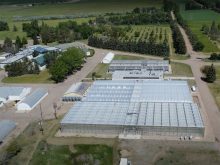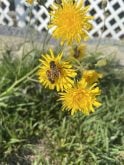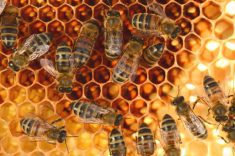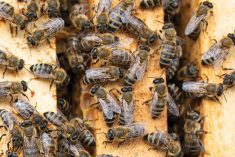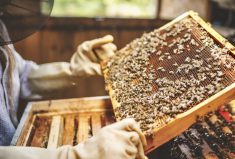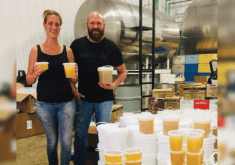Alberta beekeepers devastated by colony losses are getting a hand up through a new funding agreement.
Agriculture Financial Services Corp., through the AgriRecovery program, is compensating commercial beekeepers for “extraordinary costs” incurred during the winter of 2021-22, when extreme cold and a parasite outbreak ravaged the sector.
Overall, beekeepers lost 50 per cent of their colonies, almost twice the average losses over the past 10 years.
Read Also

VIDEO: Claas Axion 9 tractors showcase comfort features
German equipment manufacturer Claas showcased its new Axion 9 tractor series, including farmer-focused cab features, at the Agritechnica 2025 machinery show in November.
“The Alberta Beekeepers Commission is grateful for the effort and support of Agriculture and Irrigation and Agriculture and Agri-Food Canada in advocating on the commission’s behalf following one of the most devastating overwintering losses in 2021-22,” said Connie Phillips, executive director of the commission, in a news release.

“AgriRecovery will help our eligible producers to recover, building back to a viable and thriving beekeeping industry.”
Delivered by AFSC, AgriRecovery is a federal-provincial-territorial business risk management program intended to help producers recover extraordinary costs beyond what is available through other risk management programs.
The Canada-Alberta Bee Colony Replacement Assistance Initiative is a special program under AgriRecovery. It’s been set up to compensate eligible commercial beekeepers who purchased replacement colonies, bee packages or queens between Jan. 1, 2022, and May 1, 2023.
These losses were driven by untimely weather starting in spring 2021. The early start of that warm spring led to a larger-than-usual brood, which in turn spurred an increase in varroa mites, one of the most troublesome parasites of honeybees.
“Whenever there’s a lot of brood, that tends to result in a lot of varroa mites in the colonies as well, and with the extra weeks that spring, it also allowed for a couple of extra breeding cycles for the varroa,” said Phillips in an interview.
By the fall of that year, a number of colonies were infested with the mites.
“The varroa weakens the colonies in a number of ways,” said Phillips. “They are a vector for different types of viruses. They infect the larvae and the pupae of the brood and so it begins to affect and weaken the entire colony.”
Many colonies lacked the resilience to make it through the particularly long, cold winter of 2021-22.
“Winters here are tough on bees and if they’re going into winter and they’re weak, you get a smaller colony. And because the bees rely on each other in the winter to keep each other warm, you begin to run into issues,” she said.
The final nail in the coffin was the cold spring of 2022.
“Those factors, combined with weaker colonies, led to greater overwintering loss,” Phillips said.
With honey and pollination contracts on the line, affected beekeepers were in a tough position — especially considering the time required to rebuild a colony, sometimes as long as three years.
“We’re expecting not to see full numbers until not even next year but the following year, so in 2024 or 2025 we might start to see numbers coming back to normal if everything goes well,” said Phillips.
The commission reached out to AFSC and Alberta Agriculture for recovery support. Negotiations determined what would constitute “extraordinary cost” to replace colonies.
“We saw an average over the last 10 years of about 27 per cent loss in Alberta,” said Phillips.
“Twenty-seven per cent was the starting point of the discussion with AFSC and Alberta Agriculture. The extraordinary loss was 50.5 per cent or the difference. However, this is not a consideration in determining the amount paid through AgriRecovery for packages, colonies or queens.”
While Phillips feels the AgriRecovery program is “very generous”, the commission says there may be an even bigger issue at hand: regulations that limit the markets from which Alberta beekeepers can buy bees.
Under Canadian Food Inspection Agency regulations, beekeepers can import bee packages (a queen and two or three pounds of worker bees) from New Zealand, Australia, Chile, Italy and Ukraine, but generally not from the “safe zones” of the U.S. that the commission would like to trade with.
Bee supply is always at a premium, said Phillips. In the Canadian market, domestic demand for bee packages is three times higher than supply even at the best of times.
This played out during the crisis, when Canadian domestic supply, nucleus colonies and packages weren’t available early enough in the year.
“They typically are not ready until late May or early June. With a short season in Canada, this would cost beekeepers eight weeks of production,” said Phillips.
These limits have frustrated Alberta beekeepers for years, she added.
“The big push the commission has been engaged in for decades is to be able to import bees out of safe regions in the United States. There’s five countries where they’re allowed to come in from and it’s not enough.
“We need to explore the markets closer to home. It’s easier to get them. We know a little bit more about the health of the bees and they’re better suited to this climate because they’re coming out of the same climate in the same hemisphere.”
The five designated trading countries each have their own challenges, she said. Ukraine is limited due to war with Russia, while Italy was only brought into the fold recently.
Meanwhile, bees from Australia, New Zealand and Chile face long, expensive travel times and adaptability issues.
“Air Canada brings bees from Australia and they’re kind of mixed in their success,” said Phillips.
“We’ve had whole pallets of bees arrive dead just because they get overheated in the cargo holds or die from too much carbon dioxide. (Bees) create a lot of heat and carbon dioxide in the cargo hold on an airplane.”
Also, bees from the Southern Hemisphere are on different cycles and have different disease profiles compared to those in the north, which creates logistical challenges.
“There’s adaptability issues because they’re coming in from completely different parts of the world from different climates, different everything. It works, but it’s not perfect.”
The CFIA last conducted a risk assessment on importing American bees in 2013. Several of its concerns have been addressed or disproven since then, said Phillips.
“Resistant varroa mite (in the U.S.) is a concern but we know now Canada also has miticide-resistant varroa.”
Another perceived risk is resistant American foulbrood, a severe bacterial disease. Phillips thinks it’s a moot point.
“We knew we had resistance in American foulbrood even before the risk assessment was done.”
Other risks identified by the CFIA included small hive beetle and Africanized honeybees, neither of which can survive cold Canadian winters, said Phillips.
“(Africanized honeybee) crossed into the United States in 1995 and started moving northward in about 2011 but it stopped its northward migration because it doesn’t like cold weather. It can’t survive.”
The beekeeping industry needs to meet with policy-makers to encourage a more objective, science-backed view of these concerns, she said.
“We just need to get a better understanding of what the real risk is and have a less emotional, more rational discussion about whether there really is a risk. What has the U.S. done to mitigate the risks? I think all of that discussion needs to happen.”
Applicants to the Canada-Alberta Bee Colony Replacement Assistance Initiative need to submit their completed application forms and supporting documents by July 31. An AFSC identification number is required. Applications can be submitted through AFSC Connect online, in person at a branch office, or by fax.




